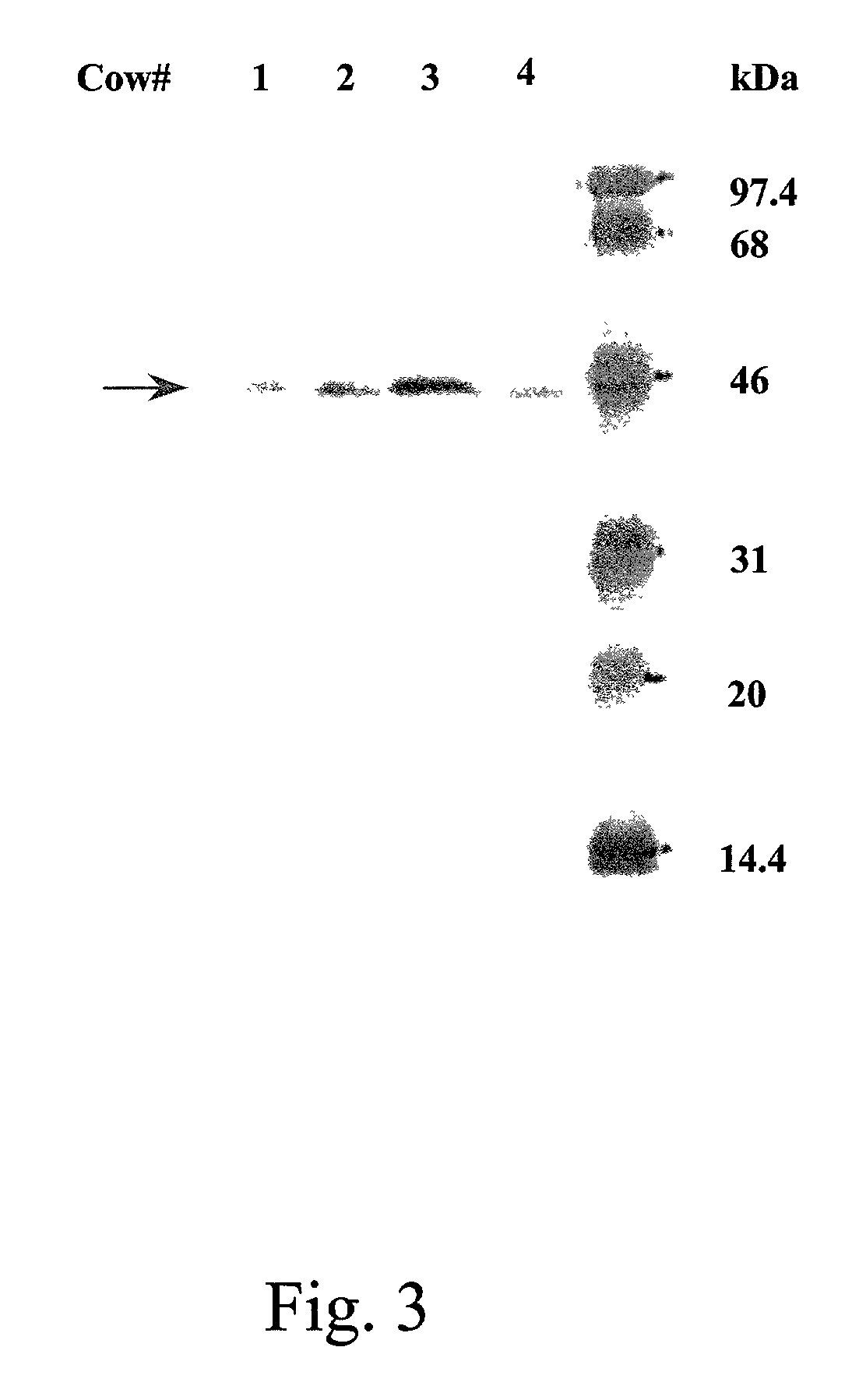Use of recombinant bovine CD14 in the treatment and prevention of coliform mastitis in dairy cows
a technology of coliform mastitis and recombinant bovine cd14, which is applied in the field of use of recombinant bovine cd14 in the treatment and prevention of coliform mastitis in dairy cows, can solve the problems of economic loss of approximately two billion dollars, decreased milk production, and the most costly disease of mastitis, so as to enhance the ability to inhibit or enhance activation, enhance immunogenicity, and enhance affinity for lp
- Summary
- Abstract
- Description
- Claims
- Application Information
AI Technical Summary
Benefits of technology
Problems solved by technology
Method used
Image
Examples
example 1
Cloning, Expression, and Purification of Recombinant Bovine Membrane CD14 and Recombinant Bovine Soluble CD14
[0096]Total RNA from the lung of a Holstein cow was isolated using Tri-reagent (Sigma, St. Louis, Mo.) according to the manufacturer's instructions. First strand cDNA was synthesized using Superscript RT II system (GIBCO-BRL Life Technologies, Gaithersburg, Md.) with an oligo(dT) primer. The cDNA coding the membrane bound (full length) bovine CD14 was PCR amplified using the sense primer boCD14F1 (5′-AAA GAATTCATGGTGTGCGTGCCCTACC-3′; SEQ ID NO:3), and the antisense primer boCD14R (5′-AAAAAGCTTACGCGMGCCTCGGGCTCCTTGMG-3′; SEQ ID NO:4). The boCD14 F1 and boCD14 R primers contained EcoRI and HindIII restriction sites, respectively, which permitted digestion of the PCR fragment with the cognate enzyme and subcloning into pUC18 vector (GIBCO-BRL Life Technologies). One clone, designated pBoCD14, was picked and its sequence was confirmed by automated sequencing.
[0097]The full length...
example 2
Detection of sCD14 in Cell Supernatants, FPLC Fractions, and Milk Whey by SDS PAGE and Western Blot
[0101]The presence, purity, and amount of rbosCD14 in selected FPLC fractions was assayed by SDS-PAGE and Western blot. Twenty microliter of culture supernatant or FPLC fraction was combined with 20 μl of 2X sample loading buffer (Novex, San Diego, Calif.), and heated at 70° C. for 10 min. For samples originating from supernatants or fractions, samples (15 μl / lane) were loaded onto two 4–12% NuPAGE gels (Novex), and separated according to the manufacturer's instructions. After gel electrophoresis, one gel was silver stained and dried, and the other gel was transferred to nitrocellulose (NC) membrane (Biorad, Hercules, Calif.). The NC membranes were blocked with 1% bovine serum albumin (BSA, Sigma) in PBS containing 0.01% Tween 20 (PBS-T) at room temperature for 60 min with gentle rocking. After blocking, the NC membrane was incubated with anti-tetra-His mAb (Qiagen) or anti-ovine CD14 ...
example 3
Expression of Bovine CD14 on the Cell Surface of Sf-9 Insect Cells
[0106]The sf-9 insect cells expressed rbomCD14 at the cell surface, as determined by cytofluorometry. The sf-9 cells were infected with recombinant virus containing rbomCD14 at a MOI of 10. At time 0 (infection), +24, +48, and +72 hr post infection, 0.5 ml aliquots of sf-9 cells (1.0×106 cells) were collected, and incubated with Rhodamine-1-(RD-1-) conjugated anti-human CD14 mAb MY4 (Coulter electronics, Hialeah, FL) at room temperature for 30 min. The cells were washed twice with ice-cold PBS by centrifugation at 100×g for 5 min. After the final wash, the cell pellet was resuspended in 500 μl of PBS, and analyzed for binding of anti-CD14 mAb with an EPICS Profile II® flow cytometer (Coulter Electronics, Hialeah, Fla.). The binding specificity of RD-1-labeled MY4 mAb was determined by pre-incubating cells with either unlabeled anti-human CD14 mAb 60bca (ATCC, Rockville, Md.), or anti-human CD14 mAb MY4 (Coulter) or is...
PUM
| Property | Measurement | Unit |
|---|---|---|
| Volume | aaaaa | aaaaa |
| Mass | aaaaa | aaaaa |
| Mass | aaaaa | aaaaa |
Abstract
Description
Claims
Application Information
 Login to View More
Login to View More - R&D
- Intellectual Property
- Life Sciences
- Materials
- Tech Scout
- Unparalleled Data Quality
- Higher Quality Content
- 60% Fewer Hallucinations
Browse by: Latest US Patents, China's latest patents, Technical Efficacy Thesaurus, Application Domain, Technology Topic, Popular Technical Reports.
© 2025 PatSnap. All rights reserved.Legal|Privacy policy|Modern Slavery Act Transparency Statement|Sitemap|About US| Contact US: help@patsnap.com



